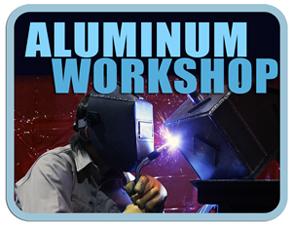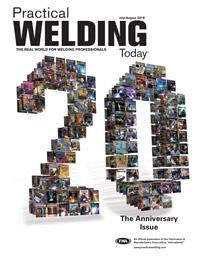President
- FMA
- The Fabricator
- FABTECH
- Canadian Metalworking
Categories
- Additive Manufacturing
- Aluminum Welding
- Arc Welding
- Assembly and Joining
- Automation and Robotics
- Bending and Forming
- Consumables
- Cutting and Weld Prep
- Electric Vehicles
- En Español
- Finishing
- Hydroforming
- Laser Cutting
- Laser Welding
- Machining
- Manufacturing Software
- Materials Handling
- Metals/Materials
- Oxyfuel Cutting
- Plasma Cutting
- Power Tools
- Punching and Other Holemaking
- Roll Forming
- Safety
- Sawing
- Shearing
- Shop Management
- Testing and Measuring
- Tube and Pipe Fabrication
- Tube and Pipe Production
- Waterjet Cutting
Industry Directory
Webcasts
Podcasts
FAB 40
Advertise
Subscribe
Account Login
Search
Aluminum Workshop: What are the advantages of AC in aluminum GMAW?
- By Frank Armao
- July 22, 2016
- Article
- Aluminum Welding
Q: Lately I have seen a few welding equipment manufacturers offering gas metal arc welding (GMAW) power sources that use alternating current (AC) instead of the direct-current electrode-positive (DCEP) current. Can you tell me what, if any, advantages there are to using AC instead of the more traditional DCEP for welding?
A: First of all, let me say that AC GMAW is not a new process. I had a few such machines in the mid-1990s. The problem with them back then was that they were prohibitively expensive. In fact, the ones I had cost over $30,000 each. Because of the high cost, AC GMAW faded from the scene until about five years ago. Thanks to advances in electronics and inverters, the price of these units is much less. The one machine I am very familiar with costs about $4,000 more than its conventional DC-pulsed power supply. So why might a fabricator want to pay the added cost for the AC-pulsed capability?
Let’s quickly review the characteristics of a DC electrode-positive (EP) arc and a DC electrode negative (EN) arc. You all know that most gas tungsten arc welding (GTAW) is performed using DCEN. In that way, most of the arc energy goes into the workpiece and provides maximum penetration. A DCEP arc puts most of its energy back into the tungsten and the torch. It provides only minimal penetration. However, it cathodically removes the oxide from the surface of aluminum. So aluminum GTAW is usually performed using AC to provide a blend of good penetration and good cleaning. When we go to GMAW, things change a bit. In GMAW, a DCEP arc provides both the best penetration and the best cleaning, which is why it is almost always used. So why might you want to use AC?
In brief, AC GMAW is very useful in welding materials that are 1/8 in. or thinner. Instead of using DC pulsing, we add an EN pulse at the end of each pulse to lower the heat input and reduce the penetration. This is beneficial for thin materials, but obviously not for thick materials. Alternatively, you can set the wire feed speed (WFS) to the same value you would use for DC GMAW and keep your travel speed the same while reducing the heat input. Additionally, by changing the ratio of the EP pulse time and amplitude to the EN time and amplitude, you can fine-tune the penetration, sort of like using the balance control on an AC GTAW machine.
The bottom line is that if you are in an industry where thicker aluminum is common, AC GMAW probably has no application in your shop. But if you fabricate thin aluminum assemblies, you might want to check it out.
About the Author

Frank Armao
Aluminum Consulting Inc.
440-479-0239
About the Publication
Related Companies
subscribe now

The Welder, formerly known as Practical Welding Today, is a showcase of the real people who make the products we use and work with every day. This magazine has served the welding community in North America well for more than 20 years.
start your free subscription- Stay connected from anywhere

Easily access valuable industry resources now with full access to the digital edition of The Fabricator.

Easily access valuable industry resources now with full access to the digital edition of The Welder.

Easily access valuable industry resources now with full access to the digital edition of The Tube and Pipe Journal.
- Podcasting
- Podcast:
- The Fabricator Podcast
- Published:
- 04/16/2024
- Running Time:
- 63:29
In this episode of The Fabricator Podcast, Caleb Chamberlain, co-founder and CEO of OSH Cut, discusses his company’s...
- Trending Articles
Sheffield Forgemasters makes global leap in welding technology

Welding student from Utah to represent the U.S. at WorldSkills 2024

Lincoln Electric announces executive appointments

Engine-driven welding machines include integrated air compressors

ESAB unveils Texas facility renovation

- Industry Events
16th Annual Safety Conference
- April 30 - May 1, 2024
- Elgin,
Pipe and Tube Conference
- May 21 - 22, 2024
- Omaha, NE
World-Class Roll Forming Workshop
- June 5 - 6, 2024
- Louisville, KY
Advanced Laser Application Workshop
- June 25 - 27, 2024
- Novi, MI



























